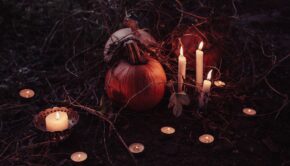The Heart of the Torah
Just a few weeks ago we finished the High Holiday season with Simchat Torah and that wonderful moment when we finish reading the Torah with the last words of Deuteronomy “l’eynei kol Israel” “in the eyes of all Israel” and, without so much as a pause to catch our breath, start reading the Torah again with “beraisheet bara…” “In the beginning of God’s creation….” The famous drash (interpretation) of this is that the last letter of the Torah is Lamed ל and the first letter of the Torah is bet ב. When we combine the ending with the beginning we get the word לב – lev – heart.
When we make that jump from the end back to the beginning we are somehow putting the heart into Torah. It is as if we are saying: this is not a book that we read and then put down. This is not a straight line that goes from beginning to end. It is a circle that never ends. Or, better, it is a spiral, in which we paradoxically do and we don’t come back to the same place. We circle around and read the same words, but they are changed because we have changed. They say you can never step into the same river twice, and we can never read the Torah exactly the same way as we read it before. We have new perspectives and the words strike us differently.
So, the weekly reading of the Torah isn’t just about acquiring knowledge, or at least that is not the heart of the matter. Yes, we get more knowledge of the text as we read it, but we get to the heart of Torah when we listen each time to what it has to say to us. Mixing and deepening the narrative of our lives with the narrative of the Torah can have a wonderful effect on our lives. I’m often amazed how the struggles of Abraham’s family, or the wanderings of the Israelites, or the ethical laws of Deuteronomy, or even the rituals of Leviticus seem to be speaking to me in my present situation. When a community all follows these narratives they form a background like a musical score to a film, giving an extra dimension to our lives.
Another entertainment analogy that comes to mind is that when a community is all tuned into the parshat ha’shavuah, it’s like we’re all watching the same T.V. drama (lehavdil! – not to really compare Torah to T.V.!) There is a narrative that everyone is talking about; there’s a gripping story and there are lessons to be learned. The main difference is that we get this series year after year – and yet it doesn’t get old.
Perhaps that’s because, in the Torah, it’s very difficult, if not impossible, to pinpoint “the meaning.” There are so many ambiguities, so many things that don’t seem to quite make sense, that it stimulates us to dig deeper, come back again, reinterpret. The great anthropologist and scholar of mythology Claude Levy-Strauss once made the observation that myth mostly disappeared as a mainstay of European culture when people started writing novels. In a novel you can tell, more or less, what the narrative is, and, with room for interpretation, what the meaning is. He also noted that when myth started to morph into novels, it left a vacuum in the culture for that depth and mystery that myth had provided. He proposed that this was the time classical music began to fill that vacuum: it evokes, it stirs thoughts and emotions, but, like myth, it doesn’t reveal its “meaning.” The Torah, even though it seems to tell stories, is actually more like music or myth than like a novel.
We in the modern world often don’t have much in the way of myths, music or narratives that hold us together as communities and give a deeper perspective on our lives. T.V. and other entertainment come and go. Music, for the most part, has become a personal preference and not something that usually defines a community. The beauty of the changing seasons is too often reflected in the mainstream culture in the latest sale displays or commercialized holiday. We’re barely done with one shopping season when we’re urged to buy something else for the next binge. We are pulled from one news story to the next, one political battle to the next crisis. Yes, it is important to keep up to date on what’s happening in the world, but where do we find perspective on it? Where do we check our core values and the truth of our hearts against the rushing urgencies of the world?
Jews have been known as the People of the Book, and on some very basic level that means reading the Book, and lettings its rhythms become our rhythms. Experiencing the Torah as the year-long, underlying story (or music) of our lives can open our hearts as we listen for the heart of the Torah.






